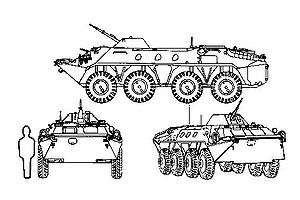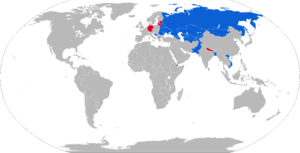BTR-70
| BTR-70 | |
|---|---|
|
BTR-70 of the Russian Ground Forces, 2015 | |
| Type | Armoured personnel carrier |
| Place of origin | Soviet Union |
| Service history | |
| In service | 1972 - present |
| Specifications | |
| Weight | 11.5 tonnes |
| Length | 7.535 m |
| Width | 2.80 m |
| Height | 2.32 m |
| Crew | 3 (+ 7 passengers) |
|
| |
| Armor |
9 mm (front) 7 mm (sides) |
Main armament | 14.5 mm KPVT machine gun or 12.7 mm DShK |
Secondary armament | 7.62 mm PKT machine gun |
| Engine |
2× gasoline ZMZ-4905 120 hp (88.2 kW) (×2) |
| Power/weight | 20 hp/tonne |
| Suspension | wheeled 8×8 |
Operational range | 400–600 km |
| Speed | 80 km/h, swim 9 km/h |
The BTR-70 is an eight-wheeled armored personnel carrier (Russian: бронетранспортер/Bronetransporter, or literally "Armoured Transporter") originally developed during the late 1960s under the industrial designator GAZ-4905. On August 21, 1972, it was accepted into service and would later be exported to the Warsaw Pact and other allies. Introduced as a successor to the earlier BTR-60, it most closely resembles a BTR-60PB. Improvements include heavier armor plating and tires less prone to puncture. In other respects, the vehicle is very similar to the BTR-60PB, both vehicles having a roof-mounted turret equipped with a heavy machine gun and a secondary co-axial PKT machine gun, but with a more powerful petrol engine configuration.
Another difference was in the location of the side doors, which on the vehicle's predecessor were located above the beltline between the second and third pairs of wheels on both sides of the vehicle. However, the designers of the BTR-70, moved the doors below the beltline. As Soviet tactics calls for unloading troops from the vehicle while it is in motion, this change increased the risk of a soldier being pulled under a wheel and injured or killed, although it also meant that the troops could get out quicker and expose themselves less to the enemy.
Like the vehicle's predecessor, it is fully amphibious with minimal preparation. A licensed Romanian copy was designated the TAB-77 and had various improvements and changes to make local production easier, including a better turret and different engines.
Equipment
The BTR-70 is powered by two gasoline engines. Early production vehicles used 115 hp GAZ-69B 6-cylinder engines, but most vehicles have the more powerful ZMZ-49-05 V-8 engines. The vehicle is fully amphibious, propelled when afloat by a single water jet mounted at the rear of the hull. To prepare the vehicle for water, the driver erects a trim vane and switches on the bilge pumps from within the vehicle.
The standard equipment includes a central tire-pressure regulation system that allows the driver to adjust the tire-pressure to suit the terrain being crossed. Also fitted is an R-123M radio set and an R-124 intercom. The driver's optical equipment consists of three TNPO-115 vision blocks and a TNP-B day vision device, which can be replaced by a TVNO-2B night vision device. The commander also has three TNPO-115s and either a TPKU-2B day sight or a TKN-1S night sight accompanied by an OU-3GA-2 infra-red search light. The turret is fitted with a PP-61AM (or 1PZ-2) periscopic sight for the gunner and the infantry group in the troop compartment is provided with TNP-B devices. The BTR-70 also has an FVU NBC filter system and a DK-3B detection device.
The armaments consist of a KPVT heavy machine gun with 500 rounds and a coaxial 7.62 mm PKT machine gun with 2,000 rounds. Also on board are two "Igla" or "Strela-3" MANPADS, and optionally two AGS-17 grenade launchers at the expense of two infantry men.
Variants

Russian Federation
- BTR-70: Basic APC version, as described.
- BTR-70 obr. 1978: Initial version, publicly displayed in 1980.
- BTR-70 obr. 1982: Improved model with 120 hp ZMZ-49-05 V-8 engines, instead of the original GAZ-49B 115 hp 6-cylinder engines.
- BTR-70 obr. 1984: Slightly modified model with an additional TNPT-1 periscope on the turret roof.
- BTR-70 obr. 1986: Improved version with a periscope on the left side of the turret and four firing ports in the hull roof.
- BTR-70V: Late-production model fitted with the BPU-1 turret of the BTR-80, with an 1PZ-2 sight, but without the "Tucha" smoke grenade launchers.
- BTR-70M: Modernized version with turret, diesel engine and rear hull section of the BTR-80.
- BTR-70D: Diesel version, developed by Muromteplovoz and powered by a YaMZ-236D 180 hp diesel engine. Prototype only.
- SPR-2 "Rtut-B" (stantsiya pomekh radiovzryvatelyam): Electronic warfare variant, designed to detonate artillery shells with proximity fuze detonators.
- SPR-2M: Modified version with more compact equipment.
- BTR-70K (komandnyj): Command vehicle with additional radios, several whip antennas, navigation device and a portable generator.
- BTR-70KShM (komandno-shtabnaya mashina): Command and control variant, designed to be used as a mobile command post.
- 2S14 "Zhalo-S": tank hunter, armed with a 2A62 85 mm gun. Prototype only.
- SA-22 (spetsapparatnaya mashina): command vehicle.
- 15Ya56M MBP (mashina boyevogo posta): base security vehicle for Strategic Rocket units. The original turret has been replaced by a new type with an 1PN22M1 improved sight, loudspeakers, OU-3GA-2 IR search lights, additional TNPO-170 periscopes and an NSVT 12.7 mm machine gun.
- BTR-80
Ukraine
- BTR-70D: Upgraded from 2001 by NRMZ and fitted with a 300 hp diesel engine. Ukrainian army vehicles additionally have BTR-80 style two-piece escape hatches in the hull sides.
- BTR-70DI (BTR-7): With Euro II 276 hp diesel engine from IVECO. Can be optionally fitted with "Ingul" or "Bug" modular turrets or with the "Zaslon" active protection system. The basic armament is augmented by an AGS-30 automatic grenade launcher and 2 AT rockets.[1]
- BTR-70M: Upgraded by Marozov and powered by a 300 hp engine UTD-20. Might be fitted with a new turret, like the "Grom" or BAU-23x2.
- BTR-70SM: Unarmed ambulance with a re-designed hull. Three different models have been observed.
East-Germany
- SPW 70 (Schützenpanzerwagen): NVA designator for Romanian-made BTR-70. 1,316 delivered between 1980 and 1990.[2]
- SPW 70(S): Locally converted staff vehicle with two extra radios, two/three whip antennas and a slim telescopic mast on the right side of the hull roof.
- SPW 70(SL): Forward air control vehicle, equipped with an R-809M2 radio and fitted with four whip antennas.
- SPW 70(Ch): NBC reconnaissance vehicle with detection and marking systems. Prototype only.
Slovakia/Belarus
- Cobra-K: Fitted with a 2A42-Cobra modular turret. Might be optionally equipped with a new KamAZ-7403 diesel engine.
Belarus
- BTR-70M-A1: Proposed upgrade from Minotaur with a diesel engine and improved transmission. The vehicle might retain the original turret or can be fitted with a new one, for example the CM30/BM30 (2A42-Cobra) "combat module".[3]
- BTR-MK a.k.a. KM-70: Proposed command vehicle (komandnaya mashina) from Minotaur with a crew of six and R-123M and R-13M radios.[3]
- MTP-K a.k.a. MTP-70: Technical support vehicle (mashina tekhnicheskoj pomoshchi), fitted with tow bars, a work platform and a light crane. This version retains the turret, but without the KPVT machine gun.[3]
Azerbaijan

- BTR-70M: Jihazgayirma Instrument Construction Plant in Baku presented some upgraded BTR-70s for the first time in March 2011. These vehicles have a new diesel engine and improved transmission. Optionally, the original machine-gun turret might be replaced with the "Şimşek" (Lightning) one-man turret. "Şimşek" was developed in partnership with South Africa's Emerging World Technologies (EWT) and appears to be a variant of EWT's Predator II light compact turret.[4]
Romania
- TAB-77 (transportorul amfibiu blindat): Romania not only built the BTR-70 under licence (for export), but also developed its own, improved version. While very similar, the TAB-77 has the same turret (with the LOTA aiming system) as the TAB-71. The original gasoline engines were replaced with Saviem 797-05M1 132 hp diesel engines.
- TAB-77 M1983: upgraded version with a 30 mm gun and 9M14M "Malyutka" ATGM. Prototype.
- TAB-77 M1984: upgraded version with a 23 mm gun and 9M14M "Malyutka" ATGM. Prototype.
- TAB-77A PCOMA (punct de commanda şi observare mobil de artilerie): artillery command and forward observer vehicle with range finders in a big, unarmed turret. Armament consists of a single, pintle-mounted 7.62 mm machine gun on the hull roof.
- TAB-77A R-1451/M: command vehicle with R-1070 and R-1451M radios. Similar to the basic APC, but with additional whip antennas and a rear-mounted generator.
- TAB-77A R-1452: signals vehicle with an R-1452 radio, low-profile "dummy turret, seven whip antennas, a telescopic mast, two generators at the rear and a pintle-mounted machine gun on the hull roof.
- TERA-77L (tractor de evacuare şi reparat auto): recovery vehicle with a 5t crane and a dozer blade.
- TABC-79: shorter version with only four wheels. Several variants exist.
- Chinese TAB-77: Chinese license built TAB-77, with a small number entering Chinese service for evaluation purpose in the 1980s. China purchased the production license from Romania in 1984, and even retained the original Romanian designation TAB-77. The Chinese built TAB-77 is heavier, weighing more than 13 tons.
Combat history
The BTR-70 was widely used during the Soviet war in Afghanistan and many smaller conflicts in Eastern Europe. After the Cold War, these AFVs saw service with the UN in the Balkans with high success.
In 2014, it was used during the 2014 pro-Russian unrest in Ukraine. At least one was captured[5] by the militias of the Donetsk People's Republic.
Operators

Current operators
-
 Armenia: 20, some upgraded with diesel engine and 23 mm gun
Armenia: 20, some upgraded with diesel engine and 23 mm gun -
 Azerbaijan: 57 possibly upgraded with diesel engine and "Şimşek" turret.
Azerbaijan: 57 possibly upgraded with diesel engine and "Şimşek" turret. -
 Belarus: 446[6]
Belarus: 446[6] -
 Cuba: 6 BTR-70M
Cuba: 6 BTR-70M -
 Djibouti: 6
Djibouti: 6 -
 Democratic People's Republic of Korea:250
Democratic People's Republic of Korea:250 -
 Georgia: 45 including some BTR-70DI. Are armed with the same armament, but have 30mm AGS and 2 AT rockets added.[7]
Georgia: 45 including some BTR-70DI. Are armed with the same armament, but have 30mm AGS and 2 AT rockets added.[7] -
 Military of Bosnia and Herzegovina: 3
Military of Bosnia and Herzegovina: 3 -
 Bangladesh:60-70 in service with Bangladesh Army. Being replaced by BTR-82A
Bangladesh:60-70 in service with Bangladesh Army. Being replaced by BTR-82A -
 Kazakhstan: 45
Kazakhstan: 45 -
 Kyrgyzstan: 45
Kyrgyzstan: 45 -
 Macedonia: 58 SPW 70, SPW 70(S) and BTR-70D
Macedonia: 58 SPW 70, SPW 70(S) and BTR-70D -
 Moldova: 5
Moldova: 5 -
 Mongolia: 40+[8][9]
Mongolia: 40+[8][9] -
 Pakistan: 120 BTR-70 / BTR-80 in service of the Pakistan Army.[10]
Pakistan: 120 BTR-70 / BTR-80 in service of the Pakistan Army.[10] -
 Romania: 170 TAB-77
Romania: 170 TAB-77 -
 Russia: 95 in service with the Naval Infantry[11]
Russia: 95 in service with the Naval Infantry[11] -
 Ukraine: 1,026[12]
Ukraine: 1,026[12] -
 Uzbekistan: 36
Uzbekistan: 36 -
 Tajikistan: 2[13]
Tajikistan: 2[13] -
 Turkmenistan: 170
Turkmenistan: 170 -
 Vietnam: 150
Vietnam: 150 -
 Palestine: 50[14]
Palestine: 50[14]
Former operators
-
 Soviet Union: Passed on to successor states.
Soviet Union: Passed on to successor states. -
 East Germany: Passed on to Germany.
East Germany: Passed on to Germany. -
 Germany: 135 to Nepal, 750 to Pakistan
Germany: 135 to Nepal, 750 to Pakistan -
 Nepal: 135 (German vehicles, used by NEPBAT in Bosnia for UN operation.)
Nepal: 135 (German vehicles, used by NEPBAT in Bosnia for UN operation.) -
 Estonia: 4, all out of service about 2005. Given to military museums, or used as anti-tank targets.
Estonia: 4, all out of service about 2005. Given to military museums, or used as anti-tank targets.
See also
Notes
- ↑ http://i070.radikal.ru/1005/08/dd7f53597ee3.jpg
- ↑ Gau L-R., Plate J., Siegert J. (2001) Deutsche Militärfahrzeuge: Bundeswehr und NVA. Motorbuch Verlag. ISBN 3-613-02152-8
- 1 2 3 Development: Minotor service
- ↑ Archived April 21, 2011, at the Wayback Machine.
- ↑ "Latest from the Special Monitoring Mission to Ukraine - based on information received up until 6 May 2014, 19:00". Organization for Security and Cooperation in Europe. Retrieved 4 March 2015.
- ↑ Belarus Army Equipment
- ↑ "Armament of the Georgian Army". Geo-army. Archived from the original on 9 March 2012. Retrieved 4 March 2015.
- ↑ bmpd - Монгольская армия получает танки Т-72 и БТР-70М
- ↑ news - БХ-ын сайд тайлангаа тавив. News.mn. Retrieved on 2013-1-25.
- ↑ "Pakistan Army". Archived from the original on 2013-10-12.
- ↑ Eugene Yanko, Copyright 1997 - info@warfare.ru. "BTR-70 Armored Personnel Carrier; Russian Arms, Military Technology, Analysis of Russia's Military Forces". Warfare.ru. Retrieved 2013-09-25.
- ↑ Ground Forces Equipment - Ukraine
- ↑ Tajik-Army Equipment
- ↑ Fifty Russian armored vehicles near delivery to Palestinian territory | Russia | RIA Novosti
References
- Gau L-R., Plate J., Siegert J. (2001). Deutsche Militärfahrzeuge - Bundeswehr und NVA. Motorbuch Verlag. ISBN 3-613-02152-8.
- A.V. Karpenko (1996). Obozreniye Bronetankovoj Tekhniki (1905-1995 gg.) Nevskij Bastion.
External links
| Wikimedia Commons has media related to BTR-70. |
- BTR-70 Technical data sheet and pictures BTR-70 ArmyRecognition.com
- ArmyRecognition - Images of TAB series
- FAS page
- Description (in Russian) and photo gallery at armoured.vif2.ru
- BTR-70 in detail (in Russian)
